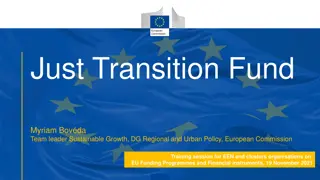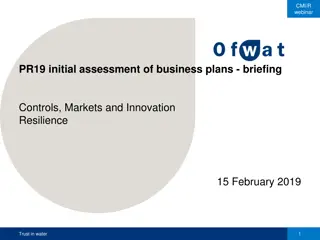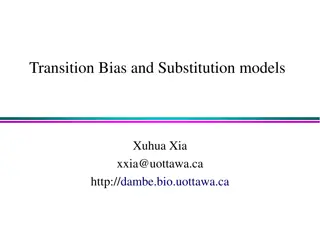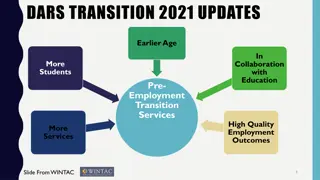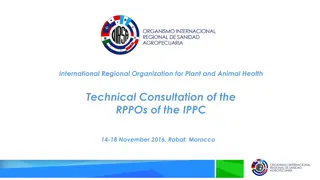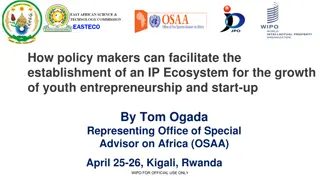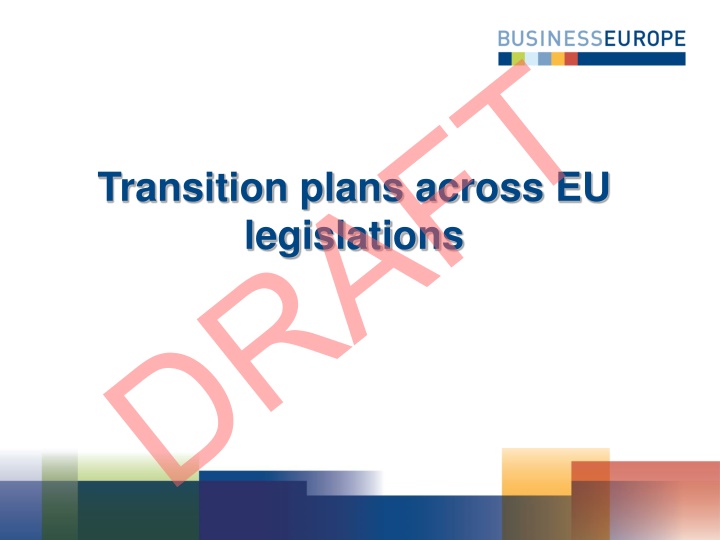
Transition Plans Across EU Legislations Initial
Mapping transition plans within EU legislation including primary, secondary, and other laws. Requirements for businesses to align with sustainability goals, emission reduction targets, and circular economy principles.
Download Presentation

Please find below an Image/Link to download the presentation.
The content on the website is provided AS IS for your information and personal use only. It may not be sold, licensed, or shared on other websites without obtaining consent from the author. If you encounter any issues during the download, it is possible that the publisher has removed the file from their server.
You are allowed to download the files provided on this website for personal or commercial use, subject to the condition that they are used lawfully. All files are the property of their respective owners.
The content on the website is provided AS IS for your information and personal use only. It may not be sold, licensed, or shared on other websites without obtaining consent from the author.
E N D
Presentation Transcript
Transition plans across EU legislations Initial + name Date (jj-mois-aaaa)
Mapping TP within EU legislation Legislation Primary Secondary Other CSRD Article 19 (a) ESRS E1 (14-17) EFRAG IG1 OECD Guidelines for Multinational Enterprises on Responsible Business Conduct (77) Article 1(c) Article 15 CSDDD n/a BAT conclusions after 1 January 2030 IED Article 27d n/a Article 10a Article 10b Article 15 Implementing Regulation EU-ETS DG CLIMA Template European Scientific Advisory Board on Climate Change & EBA Guidelines Article 76 Article 87a CRD 2
CSRD 1/2 Business model and strategy are compatible with the transition to a sustainable economy (1,5 C) and climate neutrality in 2050 At least two emission reduction targets 2030 and 2050 Based on scientific evidence CSRD Article 19a explanation of how the undertaking s targets are compatible with 1.5 C an explanation of the decarbonisation levers identified: 1. changes in product and service portfolio 2. adoption of new technologies in its own operations 3. changes in upstream and/or downstream value chain ESRS E1 an explanation and quantification of the undertaking s investments and funding supporting the implementation of its transition plan, with a reference to the KPIs of taxonomy-aligned CapEx, and where relevant the CapEx plans 3
CSRD 2/2 a qualitative assessment of the potential locked-in GHG emissions from the undertaking s key assets and products for companies that are covered by delegated regulations on climate adaptation or mitigation under the Taxonomy Regulation, an explanation of any objective or plans (CapEX, CapEx plans, OpEX) that the undertaking has for aligning its economic activities (revenues, CapEx, OpEx) with the criteria established in Commission Delegated Regulation 2021/213936; ESRS E1 Companies must disclose the plans and capacity of the undertaking to adapt its strategy and business model in line with circular economy principles including but not limited to minimising waste, maintaining the value of products, materials and other resources at their highest value and enhancing their efficient use in production and consumption; ESRS E5 4
CSDDD Obligation to adopt and put into effect a transition plan for climate change mitigation to ensure compatibility of business model and strategy of the company with the transition to a sustainable economy and with the limiting of global warming to 1.5 C. CSDDD Article 1(c) MS shall ensure that companies adopt and put into effect a transition plan for climate change mitigation, to ensure that the business model and strategy of the company are compatible with the transition to a sustainable economy and with the limiting of global warming to 1.5 and the objective of achieving climate neutrality as established in the European Climate Law, including its intermediate and 2050 climate neutrality targets, and, where relevant, the exposure of the company to coal, oil and gas related activities. CSDDD Article 22 5
CSDDD This plan shall contain: time-bound targets related to climate change for 2030 and in five-year steps up to 2050 based on conclusive scientific evidence and, where appropriate, absolute emission reduction targets for greenhouse gas for scope 1, scope 2 and scope 3 greenhouse gas emissions for each significant category; a description of decarbonisation levers identified, and key actions planned to reach the targets referred to in point (a), including, where appropriate, changes in the product and service portfolio of the company and the adoption of new technologies; an explanation and quantification of the investments and funding supporting the implementation of the transition plan for climate change mitigation; and a description of the role of the administrative, management and supervisory bodies with regard to the transition plan for climate change mitigation. MS shall ensure that the transition plan is updated every 12 months and contains a description of the progress the company has made towards the targets. CSDDD Article 22 6
Industrial Emission Directive (IED) Member States shall require that by 30 June 2030 the operator includes in its environmental management system an indicative transformation plan IED Article 27d The transformation plan shall contain information on how the installations will transform themselves during the 2030-2050 period to contribute to a sustainable, clean, circular, resource efficient and climate-neutral economy by 2050 Such transformation plans will also complement the Corporate Sustainability Reporting requirements under Directive 2013/34/EU of the European Parliament and of the Council by providing a means for concrete implementation. 8064/1/22 REV 1 - (COM 2022) 156 final/3 14/12/23 7
EU ETS 1/2 Drafting climate-neutrality plans is a prerequisite for operators to receive conditional free allocation, they can be done at company level or installation level. These plans are required for operators of installations with greenhouse gas emission levels exceeding the 80th percentile of emission levels for relevant product benchmarks. Operators of district heating installations in specific Member States must draft climate-neutrality plans when applying for optional additional free allocation. EU ETS Article 10a Climate-neutrality objective EU Climate Law Union-wide greenhouse gas emissions and removals regulated in Union law shall be balanced within the Union at the latest by 2050 8
EU ETS 2/2 A climate-neutrality plan must set out: measures and investments to reach climate neutrality by 2050 at installation or company level, excluding the use of carbon offset credits; EU ETS Article 10b intermediate targets and milestones to measure, by 31 December 2025 and by 31 December of each fifth year thereafter, progress made towards reaching climate neutrality; an estimate of the impact of each of the measures and investments as regards the reduction of greenhouse gas emissions. The achievement of the above targets and milestones must be verified in respect of the period until 31 December 2025 and in respect of each period ending 31 December of each fifth year thereafter. The Commission Implementing Regulation (EU) 2023/2441 is available here and the template here. 9
Capital Requirements Directive (CRD) 1/2 Member States shall ensure that the management body develops and monitors the implementation of specific plans that include quantifiable targets and processes to monitor and address the financial risks arising in the short, medium and long term from ESG factors, including those arising from the process of adjustment and from transition trends in the context of the relevant Union and Member State regulatory objectives and legal acts in relation to ESG factors, in particular the objective to achieve climate neutrality, as well as, where relevant for internationally active institutions, third-country legal and regulatory objectives. CRD Article 76 The quantifiable targets and processes to address the ESG risks included in the plans shall consider the latest reports and measures prescribed by the European Scientific Advisory Board on Climate Change, in particular in relation to the achievement of the climate targets of the Union. 10
Capital Requirements Directive (CRD) 2/2 By 18 months from the date of entry into force of this amending Directive, EBA shall issue guidelines to specify the content of plans to be prepared in accordance with Article 76(2), which shall include specific timelines and intermediate quantifiable targets and milestones, in order to monitor and address the financial risks arising from ESG factors, including those arising from the process of adjustment and from transition trends in the context of the relevant Union and Member States regulatory objectives and legal acts in relation to ESG factors, in particular the objective to achieve climate neutrality, as well as, where relevant for internationally active institutions, third- country legal and regulatory objectives; CRD Article 87a EBA shall update the guidelines referred to in the first subparagraph on a regular basis, to reflect the progress made in measuring and managing the development of the Union sustainability. ESG risks as well as on regulatory objectives 11
Risks of inconsistencies (1/2) Timeline of targets Companies in scope Name of the plan GHG Scope Legislation Level CSRD 2030, 2050 Company 50.000 Transition plan Scope 1,2,3, 2030, and each 5 years up to 2050 Transition Plan for climate change mitigation CSDDD Company 5.300 Scope 1,2,3 Company and/or installation 52.000 (industrial installation) IED 2050 Transformation Plan Scope 1,2 2025 and each 5 years 400-500 (industrial Installations) Company or installation Climate Neutrality Plan EU ETS Scope 1,2 Credit Not well defined institutions and investment firms CRD ? Specific plan ? 12
Risks of inconsistencies (2/2) Delegated Acts Other relevant info Legislation Fields ( .) Climate, circular economy, water, biodiversity, pollution EFRAG Transition Plan Implementation Guidance CSRD yes Transition plan under CSRD will be complaint with the requirement in the CSDDD to adopt a transition plan. Still have to abide by the additional obligation in the CSDDD to put this plan into effect and to update it every 12 months CSDDD no Climate change mitigation Climate, circular economy, water, biodiversity, pollution IED yes Synergies with the EU ETS Elements included in plans under other Union legal acts, in particular those referred to in the IED should be considered when drafting the climate- neutrality plans EU ETS yes Climate Financial risk arising from ESG Factors, in particular climate neutrality, as well as, where relevant for internationally active institutions, third-country legal and regulatory objectives (Paris Agreement?) European Scientific Advisory Board on Climate Change prescriptions and EBA guidelines to be issued CRD no 13






